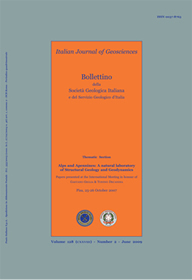
Geomorfositi in ambiente granitico: un esempio dall'alta Gallura (Sardegna nord-orientale, Italia)
Sergio Ginesu(*) & Francesco Secchi(*)
(*) Dip. Scienze Botaniche, Ecologiche e Geologiche, Università
degli Studi di Sassari, Via Piandanna, 4 - 07100 Sassari. E-mail:
ginesu@uniss.it.
DOI: https://doi.org/10.3301/IJG.2009.128.3.723
Volume: 128 (2009) f.3
Pages: 723-729
Abstract
In spite of the occurrence of spectacular forms in the granitic basement of Sardinia, geomorphosites in these environments are still poorly known. Morphosites of geological interest in northern Sardinia are mainly located along the coastline, favoured by marine activity processes forming spectacular landscapes. Recent geological surveys, focused on the evolution of the hydrographic network of north-eastern Sardinia, outline examples of morphosites of geological interest linked to the complex evolution of pluton emplacement. Schematically the major plutonic units of Sardinia batholith show mainly granodioritic and granitic composition and are broadly crosscut by late-satellite stocks mainly of fine-grained granites, as well as by a dike swarm of basaltic and aplogranitic rocks. The Fizza Ona outcrop, located near the small town of Padru west of Olbia, is a good example of morphosite in the inner zone developed at the edge of different plutonic units. It is a well exposed pillow-like horizon that does not exceed 5 m in thickness, observable in the field at least for 200 m, underlined by the occurrence of large tafoni form. In detail, the pillow-like horizon is made up of sub-roundly to sub-rounded elements of granitic to micropegmatitic rocks up to 100 cm in diameter, dispersed into the fine-grained granitic host-rock matrix; these elements are commonly edged by a continuous greenly coloured corona of aphyric rocks that does not exceed 5 cm in thickness. In the field, the observed pillow-like structure looks-like the mingling structures commonly observed for mafic and acidic magma interactions. Under the microscope however, aphyric rocks may be classified as granophyres; graphic textures are commonly observed in the surrounding fine-grained rocks. In addition, similar granitic composition observed in samples of investigated area, indicate that pillow-like structures may be due to the occurrence of local filter-press mechanism under fast-cooling conditions (i.e. granophyric and graphic textures occurrence), during the emplacement in upper crustal levels of satellite bodies. Overall, the Fizza Ona outcrop represents a quite good and rare example of emplacement mechanism of granitic magmas of the Sardinian batholith. Collapse, dismembering and complex uplift of several parts forming the hercynian collisional chain, favoured the development of deep valleys and the incision of the erosional surface in the so called «Salti di Buddusò» plateau.
The hydrographic network is strictly controlled by the structural features of exposed granitoids. The upper part of this plateau indicates a strong denudation process of the Sardinia block at the end of the hercynian orogenesis (the so-called post-hercynian penepiano), to be later redefined mainly during Oligo-Miocene time.
Many preserved forms underlined the up mentioned denudation processes testified by the occurrence of inselbergs that characterize the whole Gallura landscapes as well as the north-eastern tilting of northern block of Sardinia basement referable to the Oligo-Miocene tectonic movements.
Keywords
Get Full Text